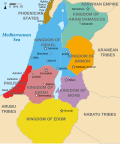Salmanu was king of Moab during the reign of the Assyrian king Tiglath-Pileser III (ruled 745–727 BCE). He is mentioned in a clay inscription found in...
861 bytes (83 words) - 16:54, 6 October 2021
Salmānu-ašarēd II, inscribed mdSILIM-ma-nu-MAŠ/SAG, meaning " Being peaceful is foremost," was the king of Assyria 1030–1019 BC, the 93rd to appear on...
6 KB (735 words) - 11:48, 8 July 2023
and a recent publication proposes the following sequence: Salmanu-zera-iqiša Liptanu Salmanu-šumu-lešir Erib-Aššur Marduk-aḫa-eriš Pišqiya Aššur-dan I...
8 KB (976 words) - 01:08, 19 June 2024
Shalmaneser V (Neo-Assyrian cuneiform: Salmānu-ašarēd, meaning "Salmānu is foremost"; Biblical Hebrew: שַׁלְמַנְאֶסֶר Šalmanʾeser) was the king of the...
38 KB (4,839 words) - 05:53, 10 June 2024
antiquity as the dynasty of E. He was a contemporary of the Assyrian kings, Salmānu-ašarēdu III) (commonly known as Shalmaneser III) (859–824 BC) and Šamši-Adad...
12 KB (1,448 words) - 05:53, 10 June 2024
Shalmaneser IV (Neo-Assyrian cuneiform: Salmānu-ašarēd, meaning "Salmānu is foremost") was the king of the Neo-Assyrian Empire from 783 BC to his death...
10 KB (1,138 words) - 23:46, 26 September 2023
pharaoh of Egypt, is born (approximate date). Karen Radner (1998). "Der Gott Salmānu ("Šulmānu") und seine Beziehung zur Stadt Dūr-Katlimmu". Die Welt des Orients...
2 KB (242 words) - 23:54, 12 February 2024
Eberhard Schrader argued that rather than Shalmaneser, Shalman was probably Salmanu, a king of Moab mentioned in an inscription of Tiglath-Pileser III. "Hosea...
1 KB (147 words) - 12:58, 12 July 2024
Shalmaneser I (𒁹𒀭𒁲𒈠𒉡𒊕 mdsál-ma-nu-SAG Salmanu-ašared; 1273–1244 BC or 1265–1235 BC) was a king of Assyria during the Middle Assyrian Empire. Son...
5 KB (539 words) - 21:30, 24 May 2022
Shalmaneser (Salmānu-ašarēd) was the name of five kings of Assyria: Shalmaneser I (r. c. 1274–1245 BC) Shalmaneser II (r. 1030–1019 BC) Shalmaneser III...
704 bytes (124 words) - 06:38, 1 May 2023
Salmanlu (redirect from Salmanu, Iran)
سلمانلو, also Romanized as Salmānlū; also known as Salmālu, Salman, and Salmānū) is a village in Mojezat Rural District, in the Central District of Zanjan...
2 KB (99 words) - 00:20, 27 March 2017
inscription of Tiglath-pileser III (r. 745–727 BCE), the Moabite king Salmanu (perhaps the Shalman who sacked Beth-arbel in Hosea 10:14) is mentioned...
32 KB (3,736 words) - 11:05, 12 July 2024
Adad-nārārī c. 1305 – 1274 BC (32 years) Son of Arik-den-ili Shalmaneser I Salmānu-ašarēd c. 1273 – 1244 BC (30 years) Son of Adad-nirari I Tukulti-Ninurta...
87 KB (7,441 words) - 19:39, 20 July 2024
Euphrates and paid tribute to Salmānu-ašarēdu III a generation or so earlier.: 201 His Assyrian contemporaries were probably Salmānu-ašarēdu IV (783 - 773 BC)...
4 KB (435 words) - 05:52, 10 June 2024
[Assur]' King of the Neo-Assyrian Empire — conquered Babylon Shalmaneser V Salmānu-ašarēd 727 BC 722 BC King of the Neo-Assyrian Empire — son of Tiglath-Pileser...
139 KB (10,567 words) - 02:09, 24 July 2024
between the kingdoms during this period. He was succeeded by his son, Šalmanu-ašaredu II, who mentions him in one of his own inscriptions and later by...
5 KB (519 words) - 08:34, 17 November 2023
Shalmaneser visited the city in the summer of the next year, he renamed it Kar-Salmanu‐ašared ("fortress of Shalmaneser"), settled a substantial number of Assyrians...
194 KB (24,924 words) - 20:06, 5 July 2024
M Danju; Ang. Hari/ K. M Hari; Ang. Kakale/ K. M Kakale; Ang. Salmanu/ K. M Salmanu; Ang. Maiturawa/ Pri. Sch. M/Rawa; Ang. Kanawa/ K. M Kanawa; Ang...
162 KB (75 words) - 04:41, 17 July 2024
confusion and a dearth of contemporary inscriptions. He succeeded his father, Salmānu-ašarēd II, whose twelve-year reign seems to have ended in confusion, as...
4 KB (402 words) - 11:48, 8 July 2023
inscription of Simbar-Šipak • Sag-gig-ga-meš (Muruṣ qaqqadi) • Sakikkū • Salmānu-ašarēdu III Epic • Synchronistic History • A Syncretistic Hymn to Ištar...
25 KB (3,254 words) - 20:35, 24 May 2024
Marduk-šāpik-zēri (c. 1082–1069 BC) through to sometime after that of Salmānu-ašarid V (727–722 BC). The narrative is divided into twenty two extant...
6 KB (733 words) - 19:45, 2 January 2024
of Šulmu-šarri. Witness is Šarru-emuranni son of Nabû-eṭir. Witness is Salmanu-reḫtu-uṣur. The portion of the document that is important in regards to...
18 KB (2,515 words) - 13:25, 30 May 2024
Assyriologie, retrieved 2022-07-02 Kühne, Hartmut (2017). "The Temple of Salmānu at Dūr-Katlimmu, Nergal of Hubšalum, and Nergal-ereš". At the Dawn of History...
102 KB (4,224 words) - 08:48, 9 June 2024
original fortification of the city is repeated in one of the later king's, Salmānu-ašarēd III, own inscriptions. It was recovered from an old adobe wall three...
4 KB (406 words) - 19:40, 10 February 2022
(in German), retrieved 2022-03-06 Kühne, Hartmut (2017). "The Temple of Salmānu at Dūr-Katlimmu, Nergal of Hubšalum, and Nergal-ereš". At the Dawn of History...
4 KB (473 words) - 09:10, 6 April 2023
been annexed under the preceding reign of Adad-nārārī I (1307–1275 BC) or Salmānu-ašarēdu I (1274–1245 BC) and Akaptaḫa (a Hurrian name) seems to have been...
5 KB (522 words) - 17:32, 23 December 2023
the locations is addressed with an invocation followed by šiptu attunu ṣalmānu apkallu maṣṣari, “incantation: you are the statues of the apkallus, the...
4 KB (624 words) - 00:24, 26 August 2022












